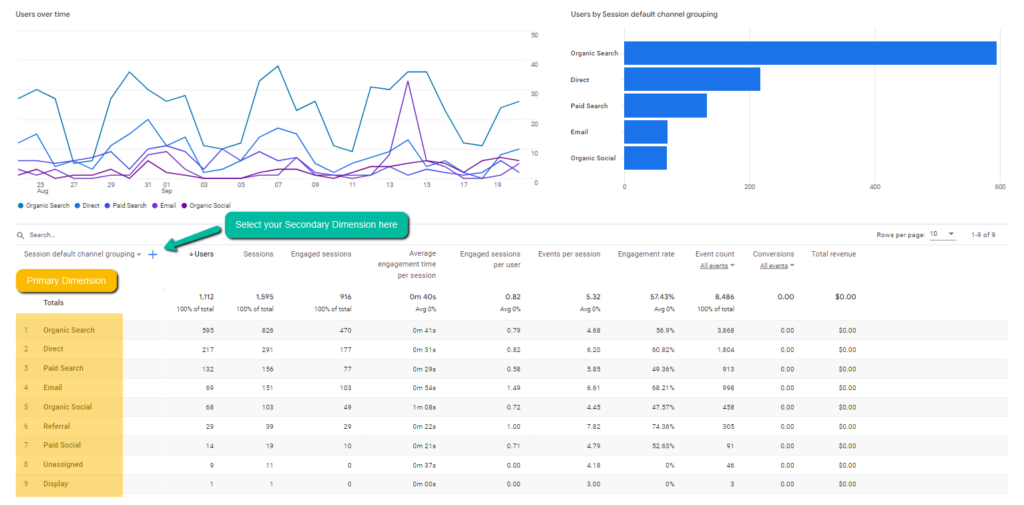Make The Most Of Coverage Precision With Secondary Measurement in Google Analytics
Comprehending just how to make best use of reporting precision with second measurements in Google Analytics can considerably enhance the depth of understandings acquired from data analysis. By incorporating additional measurements strategically, marketing professionals can uncover concealed patterns and connections that might not be promptly apparent when evaluating main metrics alone. This nuanced approach enables a much more detailed understanding of user actions and campaign performance, paving the way for even more targeted and effective decision-making. The application of secondary dimensions holds the essential to opening a wealth of important details that can transform the efficiency of electronic advertising strategies.
Understanding Secondary Dimensions in Google Analytics
To boost information evaluation and gain much deeper understandings into individual behavior, understanding second measurements in Google Analytics is crucial. Second measurements allow individuals to segment and even more dissect information beyond the main measurement selected. By including second measurements, analysts can refine their reports to disclose more comprehensive info regarding individual communications on an internet site. While the primary dimension might show the complete number of web page views, adding a secondary measurement such as 'source/medium' can supply insights into where the website traffic originated from. This additional layer of details enables marketers to analyze the effectiveness of different advertising projects or channels in driving website traffic to the site.
In addition, understanding second dimensions is important for creating much more personalized reports tailored to details business goals. By choosing the right combination of additional and key dimensions, analysts can uncover patterns, patterns, and connections that might otherwise remain concealed. This nuanced approach to information analysis equips companies to make enlightened choices based upon a comprehensive understanding of individual behavior across numerous measurements.

How to Use Secondary Measurements
When leveraging secondary measurements in Google Analytics, the useful application entails picking details information specifications to further fine-tune insights past the primary dimension's range. To use additional dimensions properly, start by accessing the report or dataset where you desire to delve deeper right into the information. Keep in mind that additional dimensions help provide context and granularity to your primary measurement information, allowing you to draw out more meaningful and actionable insights from your Google Analytics records.
Leveraging Additional Measurements for Insights
Utilizing additional dimensions in Google Analytics allows for a much more extensive analysis of information, using important understandings past the primary dimension's scope. By leveraging additional dimensions, individuals can dig much deeper into the performance metrics of their internet site or application, revealing hidden patterns and fads that might not be quickly evident when only considering primary measurements.
One trick advantage of using second measurements is the capacity to section and filter information more precisely. This can assist online marketers and experts better understand the habits of specific customer segments, such as new visitors versus returning visitors, or web traffic coming from different geographical areas.
Furthermore, second dimensions basics enable users to contrast and contrast different data points within the same report, providing a much more holistic view of efficiency (Secondary Dimension in Google Analytics). Combining the key measurement of landing pages with additional measurements like demographics or tools can disclose which pages are most effective in involving customers on various devices or from different demographic groups.
Basically, leveraging additional measurements in Google Analytics encourages individuals to remove richer insights from their information, causing even more informed decision-making and ultimately, enhanced efficiency.
Ideal Practices for Second Measurements
When assessing information in Google Analytics, integrating secondary dimensions properly enhances the deepness of understandings acquired from the key metrics. Choosing appropriate second dimensions assists in supplying context and a more clear understanding of the data being checked out.
Furthermore, it is suggested to restrict the number of additional dimensions used in a single record to stay clear of frustrating the analysis with as well much info. Concentrating on a couple of crucial secondary measurements next page at a time can result in even more actionable and concentrated insights. Additionally, take into consideration trying out different mixes of primary and secondary measurements to uncover one-of-a-kind patterns and patterns that may not be obvious when taking a look at the information alone.
Advanced Evaluation Techniques With Secondary Measurements
Discovering detailed information partnerships via the calculated application of additional dimensions can introduce nuanced understandings that raise the depth of evaluation in Google Analytics. By integrating secondary measurements with main data sets, sophisticated evaluation techniques can be utilized to extract important information.
Moreover, second measurements can boost the evaluation of conversion paths by offering added context. Recognizing the various touchpoints a user engages with prior to converting can be important in maximizing the client journey - Secondary Dimension in Google Analytics. By utilizing additional measurements to look into specifics such as web traffic resources or devices made use of, marketers can customize techniques to target high-converting channels effectively
Conclusion

To improve information analysis and gain much deeper understandings into customer actions, comprehending secondary dimensions in Google Analytics is essential - Secondary Dimension in Google Analytics. Second measurements permit individuals to section and additionally dissect data beyond the main measurement picked. While the main dimension may present the total number of page views, including an additional dimension such as 'source/medium' can supply insights right into where the website traffic originated from.When leveraging second dimensions in Google Analytics, the sensible application involves selecting specific data parameters to more improve understandings past the main measurement's range. Keep in mind that secondary measurements help give context and granularity to your main dimension information, allowing you to extract even more workable and meaningful understandings from your Google Analytics reports
Comments on “Step-by-Step Overview: Leveraging Secondary Dimension in Google Analytics”